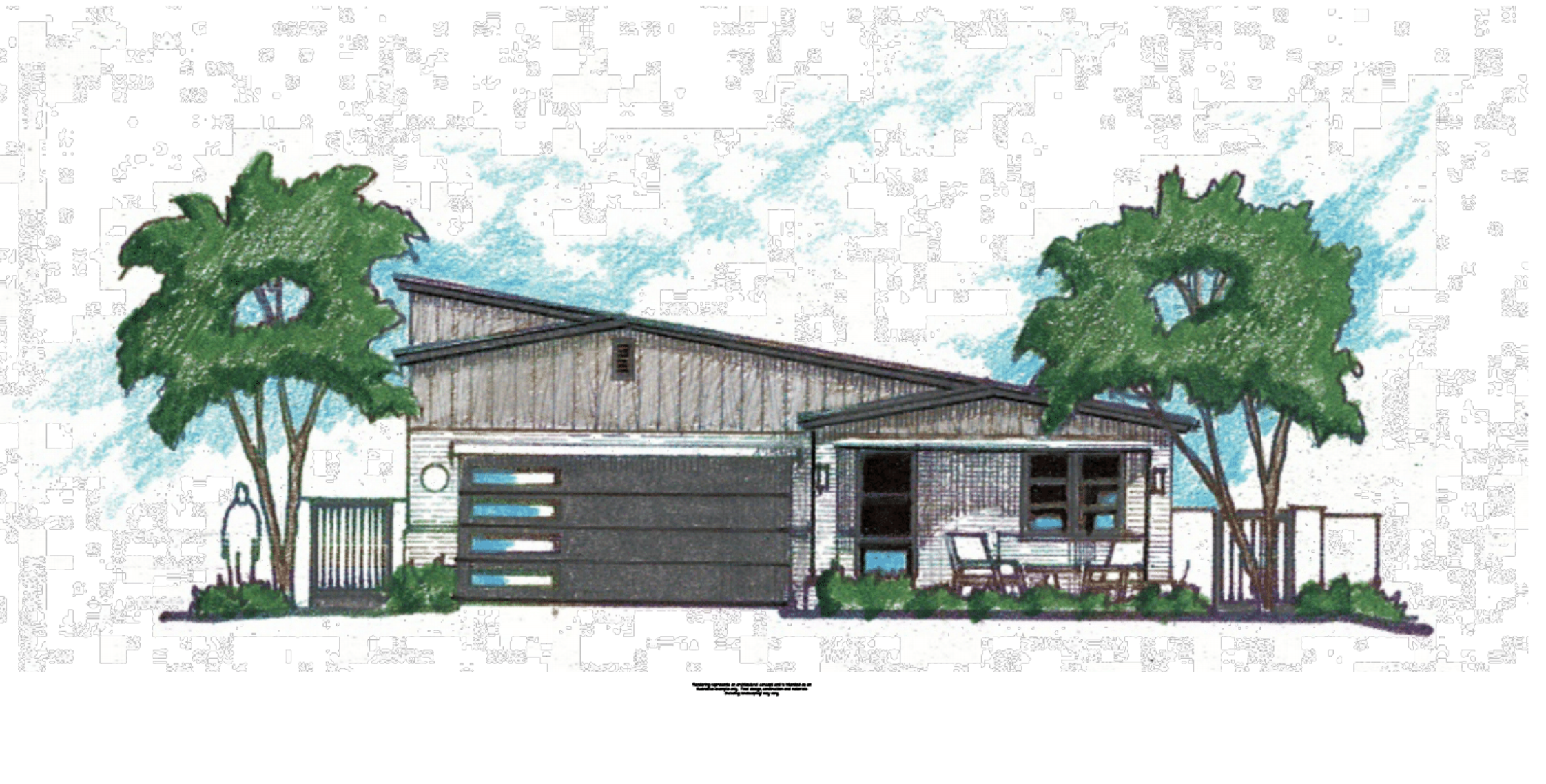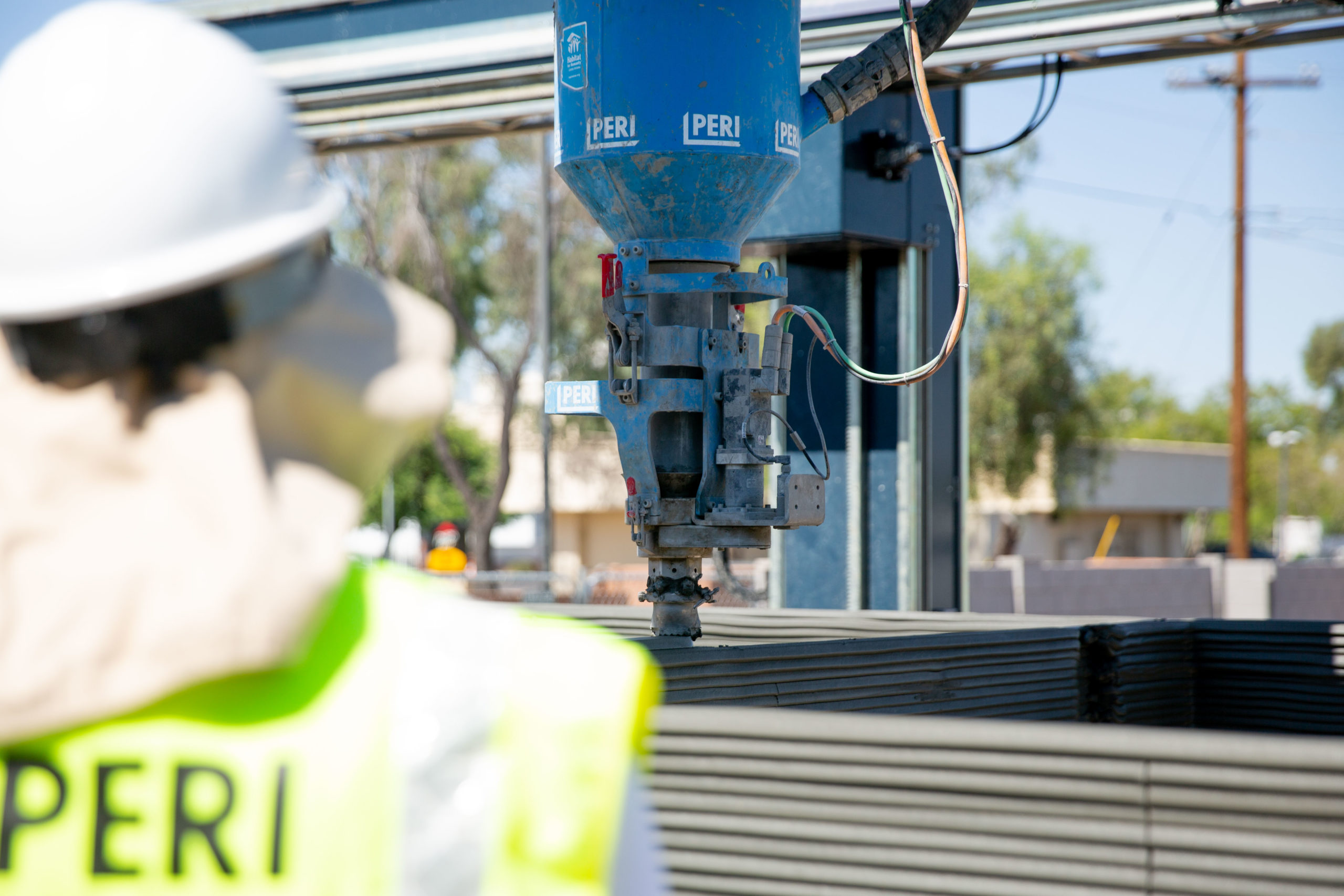Outside of WinSun, the firm that seems to be progressing the most quickly in the additive construction sector is the PERI Group. The German construction company has been using its BOD2 3D printing equipment to achieve a number of cement 3D printing firsts around Europe. It has since landed on U.S. soil where it may be scaring smaller competitors, such as ICON and Mighty Buildings, with its clout.
Its latest move is on the charitable front, 3D printing a home in Tempe, Arizona with Habitat for Humanity Central Arizona. With its sponsors, Cox and Lowe’s, and its partners—Habitat for Humanity International, City of Tempe, 3D Construction, Candelaria Design, and The Ramsey Social Justice Foundation—the firm 3D printed a three-bedroom, two-bathroom single-family home. Made up of 70 to 80 percent 3D printed material, the house measures 2,433 square feet with 1,738 square feet of living space. While the internal and external walls are 3D printed, the rest of the home is made using traditional construction techniques.
The BOD2 printer was shipped to the U.S. in March, landed in Arizona in April and began 3D printing in May. As the video below explains, the 3D printing process took just under two weeks. Construction is expected to be completed in August or September, with occupancy anticipated as early as October 2021. Income-qualified homeowners are currently being selected through Habitat Central Arizona’s standard application process.
Developed by the Danish firm COBOD, in which PERI holds a significant minority stake, the BOD2 3D printer is a gantry system measuring 2.5m along its length, width and height. Unlike WinSun and Mighty Buildings, BOD2 users produce walls on-site. The machine is certified so that workers can remain in the print area during the printing process, allowing them to lay empty conduits and connections, during the printing process.
The partners in this project have described it as “an innovative model for the future: a scalable, cost-effective homeownership solution to address the affordable housing crisis facing communities nationwide.” Tempe Mayor Corey Woods said:
“Tempe is known for innovation and this ground-breaking project aligns perfectly with our goal to identify new solutions that accelerate the growth of affordable and workforce housing in our city. Working with valued partners, we want to ensure that everyone who wants to live in Tempe can do so. Beyond our city borders, this project can serve as a model for other communities as we all work to meet the critical needs of families who truly are the faces of this growing housing affordability crisis.”
Habitat for Humanity is not without criticism, but largely performs good work supplying homes to low-income families while providing construction experience to volunteers and the homeowners themselves. Working for a non-profit dedicated to building homes for the needy is probably the best thing a former president has done in retirement. It certainly beats starting a production company.
Though additive construction companies suggest that their technologies reduce costs and waste when it comes to building homes, the argument that it will address the affordable housing crisis has is hard to validate. One housing expert told 3DPrint.com that a more cost-effective and immediate method for addressing the crisis would be to use existing, unoccupied buildings to provide homes to those in need. The expert told us that the commodification of housing, which could alternatively be categorized as a human right and provided for free by the state.
However, in the case that the housing system continues as is and building new facilities continues to be a solution for providing low-cost homes, it is possible that additive construction could reduce costs. The use of a technology that reduces human intervention, such as additive construction, is an interesting choice for a non-profit that advocates the “sweat equity” put into the building process by its future homeowners. Regardless, there is still the need for manual labor, with plenty of opportunities for Habitat homeowners to participate in the build.
Teaming with Habitat is a good choice for PERI, which is quickly expanding its footprint globally. This is a non-profit with a substantial global footprint, as well, and with plenty of experience in working with local governments to obtain the necessary approvals. Based on the sound of Habitat’s marketing-speak, this is only the first in what may be a number of 3D printed homes.
With annual revenues around €1.7 billion and about 9,500 employees, PERI is among the most sizable firms involved in additive construction. There are an increasing number of large businesses testing the waters, however. Saint-Gobain is about 10 times bigger by revenue and 20 times bigger by headcount, but has only begun making serious moves in the space recently.
What is clear is that additive construction is no longer a purely hyped technology. 3D printing is a new, but viable tool in the architecture, construction and engineering industry. We’re witnessing the beginning of an exciting segment. Where it goes exactly is still to-be-determined.
Subscribe to Our Email Newsletter
Stay up-to-date on all the latest news from the 3D printing industry and receive information and offers from third party vendors.
You May Also Like
Profiling a Construction 3D Printing Pioneer: US Army Corps of Engineers’ Megan Kreiger
The world of construction 3D printing is still so new that the true experts can probably be counted on two hands. Among them is Megan Kreiger, Portfolio Manager of Additive...
US Army Corps of Engineers Taps Lincoln Electric & Eaton for Largest 3D Printed US Civil Works Part
The Soo Locks sit on the US-Canadian border, enabling maritime travel between Lake Superior and Lake Huron, from which ships can reach the rest of the Great Lakes. Crafts carrying...
Construction 3D Printing CEO Reflects on Being Female in Construction
Natalie Wadley, CEO of ChangeMaker3D, could hear the words of her daughter sitting next to her resounding in her head. “Mum, MUM, you’ve won!” Wadley had just won the prestigious...
1Print to Commercialize 3D Printed Coastal Resilience Solutions
1Print, a company that specializes in deploying additive construction (AC) for infrastructure projects, has entered an agreement with the University of Miami (UM) to accelerate commercialization of the SEAHIVE shoreline...































